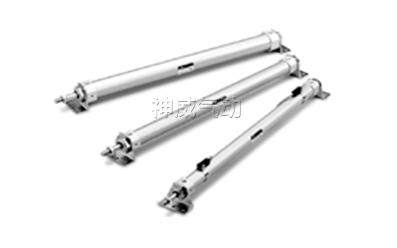The working principle of the rodless cylinder is the same as that of the ordinary cylinder, except that the external sealing form is different. Both sides of the cylinder are hollow, and the permanent magnet inside the piston rod drives the outside of the piston rod. As for the other magnet (moving part), what I want to say is that it has very high requirements for cleanliness. The rodless cylinder of the magnetic couple often needs to be disassembled and cleaned with gasoline. This may be related to its working environment.
Rodless cylinder There is a piston in the cylinder, but there is no piston rod. The piston is installed in the guide rail, the external load is connected to the piston, and the actuation depends on the air intake. The movement of the magnetic couple is achieved by using the permanent magnet in the hollow piston rod to drive the movement of another magnet outside the piston rod. Because the inner and outer magnetic rings are easy to separate when the speed is fast and the load is high, it is less used now. The size of its load mass requires finding the characteristic curve of its mass and speed. Nowadays, mechanical ones are used more often.

Classification of rodless cylinders
Rodless cylinders are divided into magnetic couple rodless cylinders and mechanical contact rodless cylinders. A rodless cylinder refers to a cylinder that uses a piston to directly or indirectly connect to an externally executed machine, and allows it to follow the piston to achieve reciprocating motion. The biggest advantage of this type of cylinder is that it saves installation space.
1. Magnetic couple rodless cylinder: The piston drives the moving body outside the cylinder to move synchronously through magnetic force. Its working principle: A set of high-strength permanent magnetic rings is installed on the piston. The magnetic lines pass through the thin-walled cylinder and interact with another set of magnetic rings set outside. Since the two sets of magnetic rings have opposite magnetic properties, they have strong suction. When the piston is pushed by air pressure in the cylinder, it drives the magnetic ring sleeve outside the cylinder to move together under the action of magnetic force. The thrust of the cylinder piston must match the suction force of the magnetic ring.
2. Mechanical contact rodless cylinder: Cylinder The cylinder tube has an axial groove, and the piston and Shangzhi move in the upper part of the groove. In order to prevent leakage and dustproof requirements, stainless steel sealing tapes and dustproof stainless steel tapes are used at the opening to be fixed on the cylinder heads at both ends. The piston frame passes through the groove to connect the piston and Shangzhi as a whole. The piston is connected to the Shangzhi and drives the actuator fixed on the Shangzhi to achieve reciprocating motion.
The difference between rodless cylinders and rod cylinders
1. Rodless cylinder: space-saving, withstands high direct load, self-guiding, cantilever load, variable stroke, end cover can be rotated 4 x 90°;, both ends Same driving force, air intake at one end, light weight, magnetic piston as standard and sensors can be installed on three sides. Built-in adjustable air buffer, lubrication is effective for a long time, and the running and stopping performance is good to avoid crawling, such as low-speed cylinders with poor sealing performance and prone to external leakage. Maximum driving force up to 3450 N, high reliability and operating performance, easy maintenance, long life (8000 km), inexpensive, easy to install, easy to operate, widely used in clamping, push-pull lifting, the cylinder extension length is longer than the cylinder Twice the trip.
2. Rod cylinder: The bending of the piston rod will cause faster wear, no self-guiding, the belt extends and retracts at different speeds;and the positioning performance is poor because The force-bearing areas on both sides of the piston are different. They are generally designed for short-stroke piston rod rotation and cannot directly support the load.






 WhatsApp: +8615857777578
WhatsApp: +8615857777578